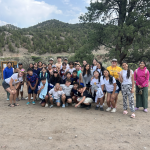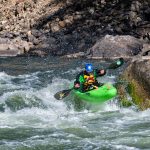Don’t slip, slide away

ALL |
It shouldn’t take a rocket scientist to figure out the backcountry in winter is a whole lot safer with at least a little common sense.
That’s the overall message from the Beaver Creek ski patrollers these days in their yearly quest to inform local skiers, snowboarders, snowshoers and anybody else taking their lives into their own hands by heading out of bounds and farther into the wilderness.
“The backcountry is unpredictable,” says Tyler Chapman, who’s working his fifth year on patrol. “It’ll get anybody.”
Chapman is one of five Beaver Creek patrollers conducting a series of seminars and workshops on avalanche safety this season.
Chapman’s role is to introduce future enthusiasts to a list of equipment necessary for safe travelling in mountainous, snow-covered terrain, including a shovel, an avalanche beacon, releasable skis, proper clothing, food and water, a first aid kit ” and matches, “in case you wind up staying out there overnight.”

Support Local Journalism
All that stuff is useless, however, if you don’t practice using it, he says.
“If something happens, you’ve got to know how to use this stuff,” Chapman says.
The most important item on the list is a good partner, someone you can trust when the chips are down, he says.
“You’ve got to have a good relationship with all your partners, and everyone should be on the same page,” he says. “If you have to go for help, you’ve just kissed your buddy goodbye.”
Common sense should dictate places to avoid in the backcountry, he says, such as:
– Cornices ” “Don’t travel beneath them.”
– Gullies ” “Terrain you want to avoid.”
– Cliffs ” “You don’t want to be on a big open face with a cliff band below you.”
Chris Bellino, a patroller for six years, likes to talk about the weather.
“Anything that happens with weather affects the snowpack,” he says, leading the group into a discussion of how rain, wind and frost events lead to the creation of distinct layers in the snow ” layers that with a trigger, such as skier moving through, can easily come crashing down a mountainside, with disastrous results.
“Weather is the most important factor in knowing what the snow is doing or has done,” Bellino says.
The Colorado High Country is one of the most “notorious” regions in the world for avalanches, he says, due to its high winds and frequent, relatively dry snowfalls. Sunny, warm spells mixed with nighttime cold spells often lead to treacherous conditions.
“Warm temperatures help snow bond better, and our snowpack can deteriorate quickly,” he says. “Unfortunately, the opposite doesn’t happen.
“And a good rain crust?” he adds. “That lasts a long time and sets up a really bad avalanche danger.”
Patroller John Clancy goes over ways the backcountry traveller can analyze snowpack before descending an untracked face. The most hands-on way to inspect what’s underneath the surface is to dig a “hasty pit,” Clancy says, revealing a sheer wall of snow with all its layers. Of course the pit should be located at about the same elevation and polar aspect as the one the backcountry traveller intends to ski or snowboard.
Clancy also recommends heeding the avalanche hazard ratings issued by the Colorado Avalanche Information Center for the region you plan to visit. “Low” means it’s a “pretty good” time to travel in the backcountry, he says; “moderate” means “it’s time to start thinking about it”; “considerable,” “high” or “extreme” typically mean “go to the movies, or get on a chairlift.”
Analyzing snow conditions is a science, says Clancy.
“People are writing theses about this stuff,” he says. “Unfortunately, all the real experts are already dead. They learned everything in an avalanche.”
Patroller Chris Berdouley says identifying avalanche terrain is key. He suggests taking along an inclinometer, which measures the angle of slope. Almost all avalanches occur on slopes of between 30 and 45 degrees, similar to many popular local black-diamond and double-diamond ski runs, such as Gengis Kahn at Vail and Bald Eagle at Beaver Creek, he says.
“We like to ski steep slopes because it gives the feeling of flying,” says Berdouley. “But you’ve got to keep thinking. Don’t turn your brains off because things in the backcountry are just so beautiful.”
Ronnie Burnett, a five-year veteran of the Beaver Creek Ski Patrol, says the No. 1 rule to follow if there is an avalanche in the backcountry is: “Remain calm.”
“If you’re buddy’s in a slide, you don’t want to go down as well,” he says.
To a crowd that, for the most part, listens quietly ” perhaps in deep thought about whether they truly want to visit the backcountry, after all ” Burnett demonstrates how use a typical avalanche beacon.
Reiterating how important it is to keep a cool demeanor and know how to use safety equipment, Burnett says by the time the ski patrol or a mountain rescue team can be summoned, it’s a body-recovery mission.
“Just remember, party members are an avalanche victim’s only real chance of survival,” he says.
For information about future avalanche safety workshops held by the Beaver Creek Ski Patrol, call Patrol Headquarters at 845-6610.










